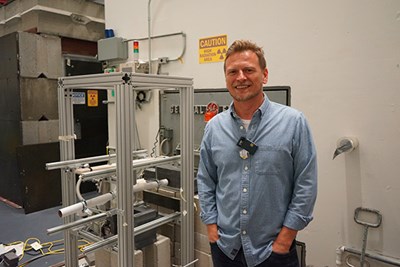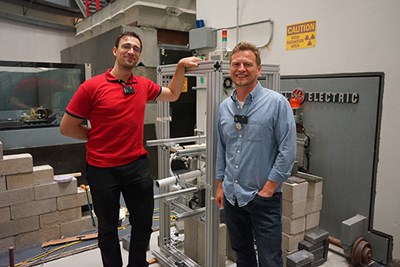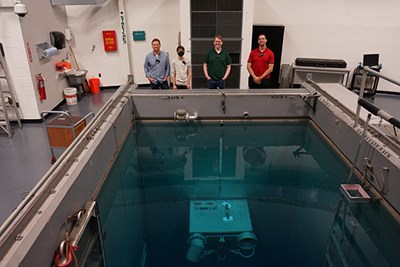UMass Lowell physics professor awarded prestigious NSF Early-Career Development Grant
Marian Jandel receives funding for research on novel cancer treatment

One in three people will be diagnosed with cancer in their lifetime, according to the American Cancer Society.
With this staggering statistic in mind, Physics Asst. Prof. Marian Jandel is researching an alternative cancer treatment that could destroy tumors in high-risk areas of the body, such as the brain.
His work is being funded by a five-year, $437,984 faculty early-career development (CAREER) grant from the National Science Foundation (NSF). The highly competitive grant is awarded to university scholars who, according to the NSF, “have the potential to serve as academic role models in research and education, and to lead advances in the mission of their department.”
“Getting a CAREER award is one of the highest honors for a junior faculty member in the sciences,” says Kennedy College of Sciences Dean Noureddine Melikechi. “And that speaks volumes about the potential that Dr. Jandel has.”
Jandel’s research will focus on neutron capture therapy, which works by injecting an initially non-radioactive compound containing a chemical element into the tumor tissue and then beaming neutrons into the area of the tumor. The neutrons react with the chemical element, producing radiation that can destroy cancer cells.
Scientists have previously studied how neutrons and the chemical element boron generate this reaction, but Jandel will be experimenting with the chemical element gadolinium.
“After gadolinium captures the neutrons, it emits X-rays, gamma rays and electrons. The electrons have enough energy that they can penetrate through cells,” says Jandel. “Our hope is that the radiation that is created can inactivate the cancer cells.”
Gadolinium has the largest probability among the chemical elements of capturing neutrons, Jandel says.

“Because of gadolinium’s nuclear structure, it literally looks too big for neutrons to miss it,” he says. “A very thin layer, almost atomic layer, of gadolinium will capture neutrons, so it’s almost a perfect absorber.”
Gadolinium also has the benefit of being non-radioactive when injected into the tumor, unlike radiation therapy treatments that are currently used. Those treatments involve the injection of radioactive substances, which not only kill cancer cells, but can affect nearby healthy cells. By beaming neutrons into gadolinium, radioactivity can be activated as needed to target the tumors.
“The goal of this therapy is to treat tumors that are inaccessible and cannot be removed by surgery,” Jandel says. “We can actually go in with a neutron beam and focus in on the tumor without damaging other tissues.”
Gadolinium stays radioactive for an instant and de-excites through a cascade of electrons and gamma rays. The high-energy gamma rays go through the body and have the potential to interact with organs and tissue.
“It’s called a secondary dose, which you don’t really want, but in many treatments, it’s there,” says Jandel. “All treatments have a secondary dose that has to be carefully evaluated.”
Jandel plans on using models of human tissue and replicas of human organs to conduct experiments that will allow him to measure the gamma rays that result from the reaction of gadolinium and neutrons, as well as how those gamma rays interact with other parts of the body. He will also be characterizing the radiation that is emitted and calculating its radiological dose.
His research will also explore the potential use of gadolinium in the form of thin films for neutron radiation detectors. Because of the unique nature of the thin film coupled with gadolinium, detection of neutrons becomes possible in environments where conventional detectors fail. Jandel says this has wide-ranging applications in homeland security and nuclear non-proliferation efforts.
Educating Students about Radioactivity
Physics Prof. Erno Sajo and Adjunct Prof. Wilfred Ngwa helped Jandel with feasibility experiments for this project in collaboration with the Dana-Farber Cancer Institute. Wil Swanson '22 also provided assistance with the preliminary tests while working toward a Ph.D. in medical physics.
Undergraduate and graduate students will continue assisting Jandel inside the 1-mega-watt nuclear reactor on campus.

Students will design stations featuring automated arms so they can put detectors and different objects in the way of the neutron beam to see how the neutrons react. They will also learn about different types of radiation, including beta radiation, X-ray radiation and gamma radiation.
Jandel’s goal is to ultimately launch a new course, Advanced Radiological Measurements Laboratory, in the Department of Physics and Applied Physics.
“This course will be used for outreach to students who don’t know much about radioactivity,” he says.
Jandel will be conducting additional research alongside Physics Asst. Prof. Peter Bender on neutron capture gamma rays from manganese as part of a $188,000 grant from the Department of Energy.
He hopes to visit high schools to talk to students about his research projects and to help them understand radioactivity through demonstrations.
“I know that there is a general fear of radioactivity despite us eating bananas, which have radioactivity (due to its potassium), getting dental X-rays and flying in airplanes (which have significantly higher radioactivity backgrounds than on sea level),” Jandel says.
“The only way to ease people’s worries is to educate them early. I also want to get more and more young people interested in nuclear and radiological sciences.”